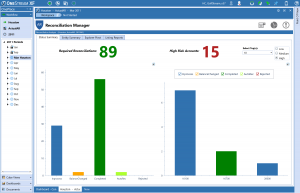There is something of a rule of thumb in business, and this rule seems to be truer now than ever before: processes work more efficiently and more effectively when they are tackled together. To put it simply, integration is key if you want to run your business in a cost-effective manner without compromising on the results you can achieve.
But what does this mean exactly in terms of intercompany account reconciliation? We know it is more efficient to integrate account reconciliation with other financial reporting processes, but are there other benefits beyond straightforward increases in efficiency and efficacy? Let's take a look.
Before and After the Reconciliation Process
Before we explore the benefits of integrating intercompany reconciliation with financial reporting processes, let's first take a quick look at the account reconciliation process itself.
The process is of course designed to check and confirm that account records are indeed correct before reporting takes place. Before reconciliation, data is confused and difficult to interpret; after reconciliation, the data is confirmed and a far more accurate and reliable report is achievable.
So, if account reconciliation is such a critical component of the financial reporting process, it makes sense that it should be incorporated into the broader financial reporting process set. However, if account reconciliation is a fairly straightforward task anyway, perhaps such integration is not necessary; perhaps the advantages of full integration are not so great. To understand this better, we need to take a look at the issues that could arise.
Potential Issues
Account reconciliation is fairly straightforward, but the results it provides are critical to the overall financial reporting process. As a result, mistakes cannot be allowed to be made. Suddenly, the process becomes far more precarious, and any issues become potential data catastrophes. But what are these issues exactly?
No end to end visibility for teams
There are many teams involved in the financial reporting process. From auditors and controllers to the GL team and the reconcilers themselves, and then, of course, the team responsible for producing the finished report, there are many links in this chain. Each team is adept at doing their own jobs, but problems arise when they look beyond this limited scope -- there is no end-to-end visibility, and no vantage point from which to view the entire process.
Miscommunication and other efficiencies
These human teams rely on human communication, and human communication is fallible. This becomes even riskier when the communication is so critical to the outcome of the reporting. A data blockage here, a misinterpreted request there, and the inefficiencies and discrepancies soon begin to add up.
No standardization
One serious issue is the lack of an international standard for reconciliation. Many organizations are expected simply to thresh out their own standards and hope for the best. This makes it difficult to achieve a smooth and reliable process.
Potential uncertainty
The human teams involved in the process are sometimes prone to guesswork and estimation on the way to completing their roles. This is, once again, due to the lack of a global standard for how this kind of work should be carried out. The result, of course, is a process with a serious potential for uncertainty.
Advantages of Automating
So, crafting an integrated solution will iron out and eliminate many of the problems listed above. For example, the end to end visibility is solved by assigning and monitoring specific reconciliation tasks with due dates that the whole team can view. Miscommunication is exterminated by workflow guidance and even tutorials that give a clear understanding of what is aksed for. In an automated process, the company uses a standard reconcile template with the right guidance making users understand the outcome. Guesswork is eliminated with the right EPM, having data automatically loaded from an underlying ERP with the right checks within the guided workflow.
Within the OneStream EPM platform you can integrate Account Reconciliation in your consolidation and close process. This saves a hugh amount of work when it is year-end closing time because of the transparent workflow functionality. The workflow with guidance and even tutorials gives a clear understanding of what is asked for in the reconciliation tasks. It even enables users to have a clear overview of which figures changed and should be reconciled once more.
We are perfectly able to advise you on the standardization and the design of this process. This is our specialty, we already succesfully crafted an integrated solution at more than 20 companies spread over 7 countries. You can dig into the software we love to work with in the OneStream Account Reconciliation e-book! When you are ready, contact us for implementation advice.

